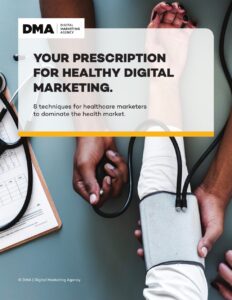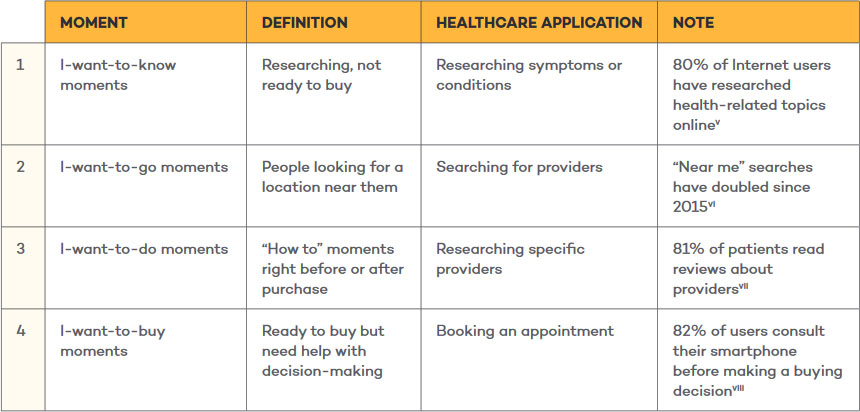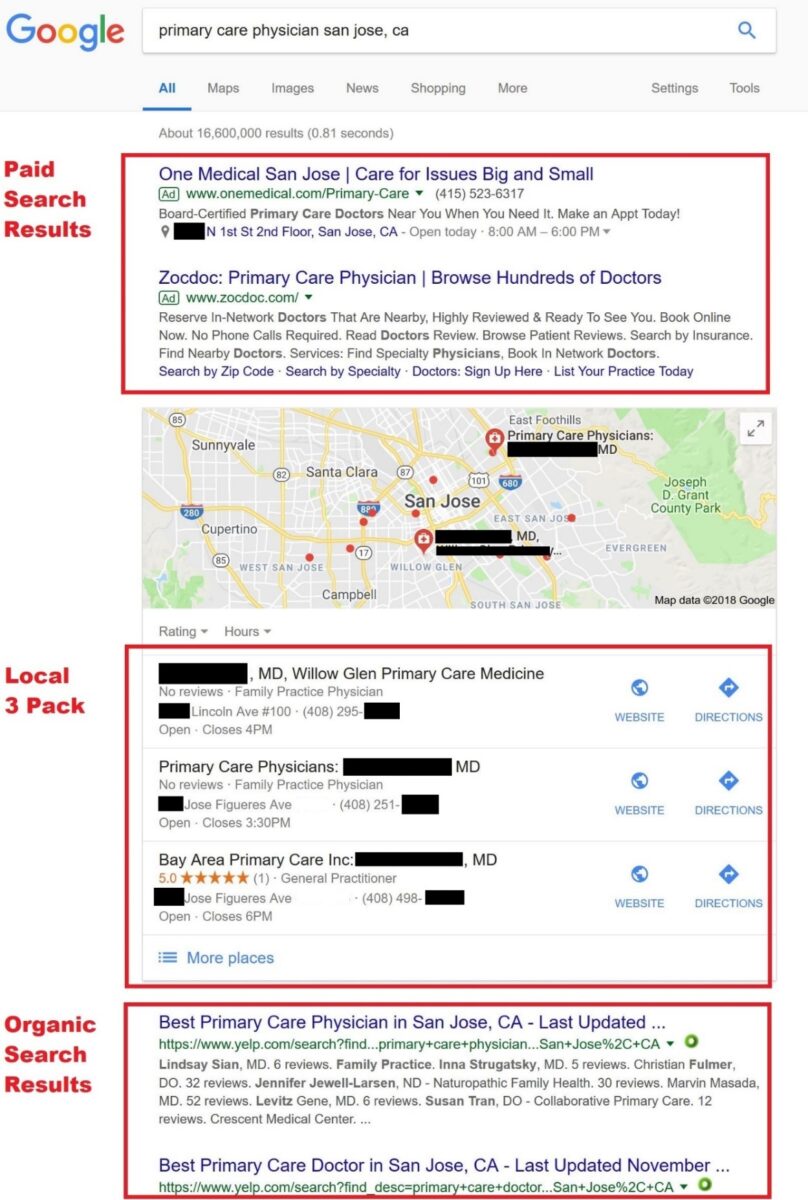SEO
Free SEO Analysis
SEO Services
Content Marketing Services
Local SEO
Link Building Services
Specialized SEO Services
PPC
REPUTATION MANAGEMENT
Free Reputation Management Analysis
Reputation Management Services
Review Management Services
Specialized Reputation Management Services
CEO Reputation Management
Brand Enhancement
Business and Directory Listings
Comprehensive Reputation Management Audit
SOCIAL MEDIA
Free Social Media Analysis
Specialized Social Services
WEB DEVELOPMENT
Free Website Analysis
Web Design Services
Mobile Development Services
Website Maintenance Services
Specialized Development Services
MARKETING AUTOMATION
Free Marketing Automation Analysis
Specialized Marketing Automation Services
Comprehensive Marketing Automation
INDUSTRIES
ABOUT DMA
WHITEPAPER
Your Prescription For Healthy Digital Marketing
Healthcare
17th May 2022
Executive Summary
Consumers spend an average of 4.7 hours each day on their smartphones.
Healthcare concerns may be global, but for healthcare providers, SEO is local.
From a healthcare perspective, videos present an opportunity to create a connection between provider and patient, cultivating trust while helping patients learn more about their health concerns.

Increased digitization and mobilization, combined with the ongoing "retailization" or "consumerization" of healthcare, has transformed the relationship between health providers and patients.
In today's online, hyper-connected, consumer-aware world, healthcare organizations and providers will struggle to compete in a fast-changing marketplace if they don't meet their future patients where they live: in an increasingly digital landscape.
This is a world where nine out of ten consumers research healthcare issues online, and seven out of ten scrutinize provider reviews before booking appointments. Modern patients are more tech-inclined, health-conscious, and provider-discerning than ever. They have come to demand the same convenience, availability, and ease-of-use from health care services as from any consumer or retail experience. If they can't get that experience from one medical provider, they'll look for another.
If healthcare organizations want to reach the tech-savvy consumer of today, they'll have to implement digital-friendly marketing techniques. Short-term Band-Aids® won’t work here. Only an effective, long-term marketing plan will cure your biggest marketing headaches.
But here’s the good news: by putting digital marketing best practices to work, healthcare organizations will instantly upgrade their marketing, out-compete other providers who are slower to adopt, and better contend with the retailization of healthcare.
In this paper, we'll discuss eight digital marketing techniques that will empower you to meet tomorrow's healthcare marketing needs today.
Micro-Moment Marketing
People are online – and typically on their mobile device – almost constantly throughout the day. Consumers spend an average of 4.7 hours each day on their smartphones.[i] Apple says its device users unlock their phones 80 times every day.[ii]
That's because people dive into the digital world for all kinds of tasks, from researching interests to locating nearby businesses to making purchasing decisions.
This is where "micro-moment marketing" comes in.
Google's content marketing team, Think with Google, describes micro-moments as “critical touch points within today’s consumer journey, and when added together, they ultimately determine how that journey ends.”[iii]
They identify four specific touch points, as indicated in the table below. These moments present key opportunities for marketers to reach customers. If you can present the right message at the right moment, you can garner both interest and traffic – and quite likely snag a new prospective patient.
These moments are closely tied to mobile device usage, which is why the frequency and duration of usage are so important.
Think with Google adds, "Micro-moments provide an opportunity for value-based exchanges in an era of fleeting attention spans as consumers bounce between various digital touch-points."
When it comes to healthcare, marketers need to be paying attention to this idea.
The retailization of healthcare has created an environment in which consumers are constantly comparison shopping and performing due diligence on health providers. To catch consumers, healthcare marketers need to give them the information and content they want, exactly when and where they want it.
As the American Marketing Association says of micro-moment marketing, "By using micro-moment marketing, brands can move the customer’s journey forward and deepen their relationship with users."[iv]

The Patient Portal
If your website and patient portal haven't been updated recently, they might be turning away more prospective patients than you realize.
That's because most patient portals and patient-facing websites are poor quality. Many were launched more to qualify for meaningful use reimbursements from CMS than to serve patients.
However, patient portals and websites are increasingly key to attracting new patients, and when they fail, they degrade the relationship with the patient. Research has found that 11% of visitors to a hospital or health system say their website experience created new, negative feelings about that brand.[v]
So, what makes a good website in the age of the consumer?
Convenience is key, with features like these:
Access
Online Booking
Self-Scheduling
Local Search Engine Optimization (SEO)
83% of patients visit a hospital's website before booking a treatment or procedure.
Healthcare concerns may be global, but for healthcare providers, SEO is local.
Your prospective patients are most often researching providers in their immediate vicinity. So, not only are 89% of consumers turning to a search engine to help answer their healthcare queries, with 83% of patients visiting a hospital’s website before booking a treatment or procedure, they're also looking for a local solution specifically.[vi] [vii]
That means your online marketing needs to achieve two goals: you need to show up on Page One of search results (three-quarters of web searchers never look past the first page), and you need to show up in the local listings (often called the "Local 3 Pack" – see the next page for a breakdown of Google search results). Your SEO efforts need to target local consumers and concerns.
Thankfully, undertaking local SEO comes with some good news.
First, it's easier to compete for placement in search results with local SEO than with nationwide searches.
Second, "showing up" produces very strong results. If you appear on the first position of Google search results, you’ll enjoy a fantastic 33% clickthrough rate.[viii] Further, SEO leads have a 14.6% average conversion (booking) rate, according to Search Engine Journal. By contrast, outbound leads like print ads have only a 1.7% close rate.[ix]
Sample Google Search Results

Social Media
Healthcare marketers use social media far less often than other marketers: only 26% of hospitals in the U.S. use social media.[x]
Yet industry analysts at PricewaterhouseCoopers report that social media can directly influence patient decisions.[xi] This is particularly true among the so-called "digital native" generations; 18- to 24-year-olds are more than twice as likely as 45- to 54-year-olds to use social media for health-related discussions.[xii]
Targeting social media for healthcare can include channels you might not consider at first.
For example, YouTube traffic to hospital sites has increased by 119% year-over-year.[xiii]
Video Marketing
Video marketing is such an important feature of modern digital marketing that it bears a closer look. Whether hosted on YouTube, another social media channel, or on a landing page, video is a powerful medium. It can educate, reassure, persuade, and motivate patients all at once.
Further, video marketing has an excellent track record of deeply engaging viewers. Think with Google has found that nearly half of internet users look for videos related to a service before making a purchasing decision.[xiv] Software giant Adobe reports that online shoppers who view demo videos are 1.81 times more likely to commit to a purchase than non-viewers.
From a healthcare perspective, videos present an opportunity to create a connection between provider and patient, cultivating trust while helping patients learn more about their health concerns.
Texts and Call Tracking
The ongoing retailization of healthcare makes medical providers more vulnerable to the negative effects of disengagement in consumers.
That means you're at greater risk of churn, or turnover in patients who decide not to return, as well as reduced rates of follow-through. No-show rates exemplify this idea perfectly: a review of multiple studies found an average 23% no-show rate for patient appointments across all specialties.[xv]
Technology can help. For example, one healthcare group reduced no-shows by 22% and increased their marketing reach by deploying a text messaging app.[xvi] This helps to align patient engagement and marketing with the device they use most often (see the "Micro-Moment Marketing" section above).
Mobile Apps
We touched on the importance of the mobile experience in the "Micro-Moments Marketing" section above, but this aspect is also worth a deeper look. It's not merely getting marketing messages onto smartphones and tablets; healthcare patients increasingly want to be able to handle health-related activities from their mobile device.
Thankfully, it's not strictly necessary to develop and market a complete, self-contained app (which must then be constantly maintained and updated on multiple device platforms).
To bridge the gap between a traditional website and an app, healthcare organizations might opt for progressive web apps. These are websites that are designed and optimized for a variety of screens. They offer all the functionality of a fully-featured website but appear on mobile devices with the elegant appearance and simplicity of a native app.
Patient Reviews
Today's medical providers already focus on patient satisfaction. Aside from patient experience being a key metric in a consumer-centric world, patient satisfaction can also affect reimbursement. CMS bases a portion of reimbursements on patient scores on the Hospital Consumer Assessment of Healthcare Providers and Systems (HCAHPS) patient satisfaction survey.
But today's patients don't limit their opinion to the HCAHPS survey; they turn online to the many medical review sites and aggregators, as well as comment on their experiences via social media. Providers cannot ignore this vital aspect of the digital experience, given that 72% of patients use online reviews as their first step in finding a new doctor.[xvii]
In fact, it's not just patients. The Google algorithm that determines whether local businesses show up in the Local 3-Pack (see the "Local SEO" section above) considers online reviews as a major factor.
Are you ready to seize the digital future?
Most healthcare providers are understandably wary when it comes to technology and anything digital. Perhaps they’ve had uneven experiences with their Electronic Health Record (EHR) systems or have been disappointed by their previous attempts at updating their websites or patient portals.
If nothing else, many providers worry about the time, manpower, and skills required for technology investments. Indeed, many healthcare groups are constrained by a lack of in-house expertise and a sometimes-unwieldy organizational size and structure that makes effective technological and online campaigns a challenge at best.
Thankfully, the digital marketing techniques described in this paper are not nearly as difficult to adapt as they might seem on the surface. Even better, the overlap between them is significant, so progress in one area will automatically improve others. For example, when you upgrade your review and reputation management, you simultaneously advance your local SEO efforts.
The only question is, will you take the steps needed to dominate the digital landscape, or leave it to other providers to eclipse you?
[i] http://www.digitaltrends.com/mobile/informate-report-social-media-smartphone-use/
[ii] https://developer.apple.com/videos/play/wwdc2016/705/
[iii] https://think.storage.googleapis.com/images/micromoments-guide-to-winning-shift-to-mobile-download.pdf
[iv] https://www.ama.org/publications/MarketingNews/Pages/digital-marketing-micromoments.aspx
[v] https://www.hcic.net/docs/default-source/insights-2014/2014-nationwide-omnibus---hcic-presentation.pdf?sfvrsn=2
[vi] https://www.thinkwithgoogle.com/intl/en-aunz/marketing-resources/micro-moments/micro-moments-guide-how-australians-find-and-choose-health-services/
[vii] https://www.mdconnectinc.com/medical-marketing-insights/digital-marketing-stats-medical-marketers
[viii] https://searchenginewatch.com/sew/study/2276184/no-1-position-in-google-gets-33-of-search-traffic-study
[ix] https://www.searchenginejournal.com/seo-101/seo-statistics/
[x] http://oxzin.com/blog/importance-of-seo-health-care/
[xi] http://www.pwc.com/us/en/health-industries/health-research-institute/publications/health-care-social-media.html
[xii] https://www.mediabistro.com/alltwitter/files/2012/12/social-media-healthcare.png
[xiii] http://www.google.com/think/research-studies/the-digital-journey-to-wellness-hospital-selection.html
[xiv] https://www.thinkwithgoogle.com/infographics/shopping-micro-moments-mobile-trends.html
[xv] https://www.sciencedirect.com/science/article/pii/S0168851018300459
[xvi] http://smithandjones.com/wp-content/uploads/2017/10/SJ-1390-2018-Trends-Playbook_lres-1.pdf
[xvii] https://www.softwareadvice.com/resources/how-patients-use-online-reviews/
Our Sales team